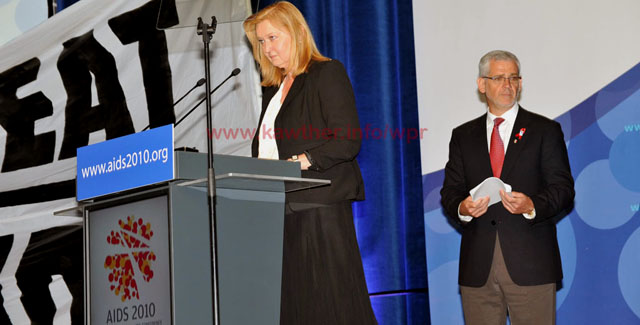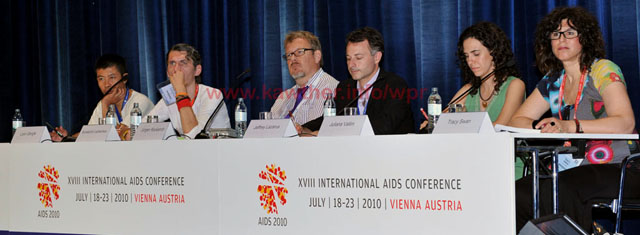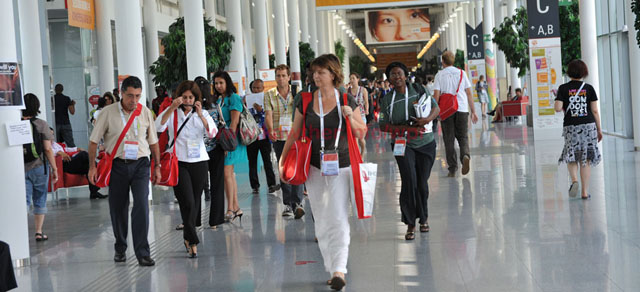HIV Epidemic at a Crossroads

Wiener Messe Conference Center.
Vienna was chosen as the host city for AIDS 2010 in part due to its proximity to Eastern Europe and Central Asia (EECA), a region with a growing epidemic fueled primarily by injecting drug use. Conference delegates will examine the epidemic in EECA, as well as in all other regions. Home to two thirds of all people living with HIV and AIDS, Southern Africa remains the most heavily affected region globally. Click here to see photos from AIDS 2010 conference. Click here to see photos from the opening session of the conference. Click here to see photos of condomize campaign at AIDS conference 2010
Austrian President Dr. Heinz Fischer and Minister of Health Alois Stöger welcomed
delegates. Other speakers included South African Deputy President Kgalema Motlanthe, European Union Commissioner of Health and Consumer Policy John Dalli, and community representatives Vladimir Zhovtyak and Alexandra (Sasha) Volgina, from Ukraine and Russia, respectively. Youth activist Rachel Arinii Judhistari from Indonesia, UNAIDS Executive Director Michel Sidibé and singer, and songwriter, activist and UNAIDS International Goodwill Ambassador Annie Lennox also addressed delegates.
Today, the biennial meeting of the global AIDS community concluded today with clear evidence of tangible progress in HIV research and program scale up, yet facing an urgent need for increased resources, the protection of human rights, and broader use of scientifically sound prevention strategies.
“International governments say we face a crisis of resources, but that is simply not true: The challenge is not finding money, but changing priorities. When there is a Wall Street emergency or an energy crisis, billions upon billions of dollars are quickly mobilized. People’s health deserves a similar financial response and much higher priority,” said Dr. Julio Montaner, AIDS 2010 Chair, President of the International AIDS Society and Director of the B.C. Centre for Excellence in HIV/AIDS in Vancouver, Canada. “Billions of people stand in solidarity with us in our drive for universal access. We must rally their support behind Michel Sidibé’s Prevention Revolution and Treatment 2.0 initiative and UNAIDS to ensure that world leaders do not turn their backs on their pledge to reach the goal of universal access.”
AIDS 2010 drew 19,300 participants from 193 countries. The week-long program featured 248 sessions covering science, community and leadership. The conference was supported by 770 volunteers from Vienna and elsewhere.
“The legacy of Vienna is the proof that we can scale up treatment and prevention to all those in need,” said Dr. Brigitte Schmied, AIDS 2010 Local Co-Chair and President of the Austrian AIDS Society. “Despite the formidable obstacles in our path, we leave here with renewed energy to maintain momentum.”

Dr. Brigitte Schmied, President of the Austrian AIDS Society
Dr. Schmied said before at the opening session of the conference: “In the past five years, the coverage of HIV treatment in low- and middle-income countries has increased tenfold to now reach five million people,” said Dr. Brigitte Schmied, AIDS 2010 Local Chair and President of the Austrian AIDS Society. “Just ten years after AIDS 2000 in Durban, we have shown the sceptics that universal access is achievable; that this is a goal we can and must reach,” she said. “Holding ourselves and our political leaders accountable for this goal, especially as the next Global Fund replenishment approaches, is our continued challenge in the months ahead.”
Vienna Declaration: By the close of the conference, more than 12,725 individuals had signed the Vienna Declaration, the official declaration of the XVIII International AIDS Conference. On Thursday, the First Lady of Georgia, H.E. Sandra Elisabeth Roelofs, signed the declaration, adding her voice to the call for more rational and scientifically sound drug policies to strengthen HIV prevention for people who use drugs.

One of the closing sessions.
Closing Features Examination of Conference Issues: Rapporteur reports in each of the scientific tracks and program areas examined the key issues addressed by conference delegates over the past week and will play an important role in evaluating the conference and its impact.
The Closing Session featured a video address by South African Archbishop Desmond Tutu, remarks by Rachel Ong, Chair of the Global Network of People Living with HIV, and Patricia Perez, Chair of the International Steering Committee of the International Community of Women Living with HIV/AIDS. Montaner and Incoming IAS President Elly Katabira, Professor of Medicine at Makerere University in Uganda, presented the first IAS Presidential Award to Jack Whitescarver of the U.S. National Institutes of Health and Katabira gave an inaugural address.
At the conclusion of the Closing Session, representatives of the AIDS 2010 local partners officially transferred the International AIDS Conference globe from Vienna to Washington, DC, which will host the XIX International AIDS Conference in July 2012. Accepting the globe for DC were AIDS 2012 Local Co-Chair Dr. Diane Havlir and representatives of the AIDS 2012 local partners.

AIDS 2010 conference.
Earlier today, delegates heard from three plenary speakers.
HIV and Incarceration: Prisons and Detention
The first of today’s plenary presentations featured two speakers. Dmytro Shermebey (Ukraine) of the All-Ukranian Network of PLHA offered a powerful account of his personal fight for survival during a nine-year prison sentence served in a Ukranian jail where he contracted HIV, hepatitis and tuberculosis. He survived because he wanted to prove that prisoners are humans who have a right to life, respect, understanding, help and protection.
UN Special Rapporteur on Torture, Manfred Nowak, said there is an urgent need for a comprehensive reform of the criminal justice and prison system to ensure an adequate response to the HIV/AIDS epidemic and detainees’ human rights. The prevalence of HIV/AIDS and TB in prisons and the measures authorities take to deal with it, impact – and often violate – detainees’ human rights. It is often forgotten that while prisoners are denied their right to liberty, they have not abrogated their other rights, such as the right to health or the right to freedom from cruel and unusual punishment.
For several reasons, prisons are characterized by particularly high HIV prevalence and are conducive to the spread of the epidemic. The transmission of HIV largely is due to risk behaviour and the failure of states to provide harm reduction measures. Evidence-based interventions, such as voluntary HIV testing and counseling and the provision of condoms, needles, syringes and opioid substitution therapy, would provide effective means to contain the spread of HIV. However, locked up behind prison walls, the fate of detainees is largely forgotten by society. The mere fact that about 30 million detainees enter and leave prisons every year highlights that prisoners’ health is a pressing public health issue.
Care and Support: Integral to Comprehensive Care
Elizabeth Gwyther (South Africa) of the Hospice and Palliative Care Association of South Africa called for the integration of HIV treatment, care and support programmes to ensure comprehensive HIV care to meet the needs of PLHIV. Gwyther described the experience of PLHIV beginning at the time they present to health care providers, often because of an opportunistic infection, highlighting the complex interventions and continuity of care they need to maintain their health and mitigate HIV’s impact on their socio-economic status. She noted that palliative and supportive care should not be reserved for end-of-life care because it plays an important role in promoting health restoration.
Gwyther also spoke about the experiences of community care workers who work on the front-line of the community response to HIV, saying that many are undervalued and do not receive the recognition they deserve. In addition to a policy for integrated HIV care, she called for governments and donors to provide accessible funding to support the community-led response to HIV/AIDS.
Hepatitis C: Cure and Control, Right Now
Dr. David Thomas (United States) of the Johns Hopkins School of Medicine said HIV and HCV confection is a serious and common problem, particularly among people who acquired HIV through drug use, and causes liver disease that is not sufficiently controlled by antiretroviral therapy. HIV/HCV co-infected persons die at a much higher rate than people with only one of the two infections, and liver failure is now the second leading cause of death among PLHIV on antiretroviral therapy.
While there are major challenges in addressing hepatitis C, HCV infection is curable and major improvements in treatment are expected within the year. Thomas called for scale-up of hepatitis C testing, particularly among PLHIV, and new ways to integrate HCV treatment with comprehensive HIV health and wellness services. Major challenges to an effective scale-up exist as HCV screening is uncommon and engaging people who use drugs in traditional medical care can be difficult.
Possibly related posts (automatically generated):
- Thanks Thanks to my father, who taught me to know when to say Yes to the things which are right, and...
- Tackling the Threat of Drugs See more photos At the United Nations, M-Building, Room M2 at Vienna International Centre (VIC) there were three big blue...
- Jifna, is not ISRAEL From: John <… @gmail.com> To: kawther_salam [at] yahoo [dot] com Sent: Sun, February 7, 2010 1:20:48 PM Subject: Fwd: [pscnorth]...
- Demands of Trials “All the Journalist Unions should move from statements of solidarity with the Palestinian journalists to real actions and measures, as...
- Israel Lost IFJ … Israel lost, and Palestine and Iraq won the elections of the Executive Committee (advisors) of the International Federation of...










No comments:
Post a Comment